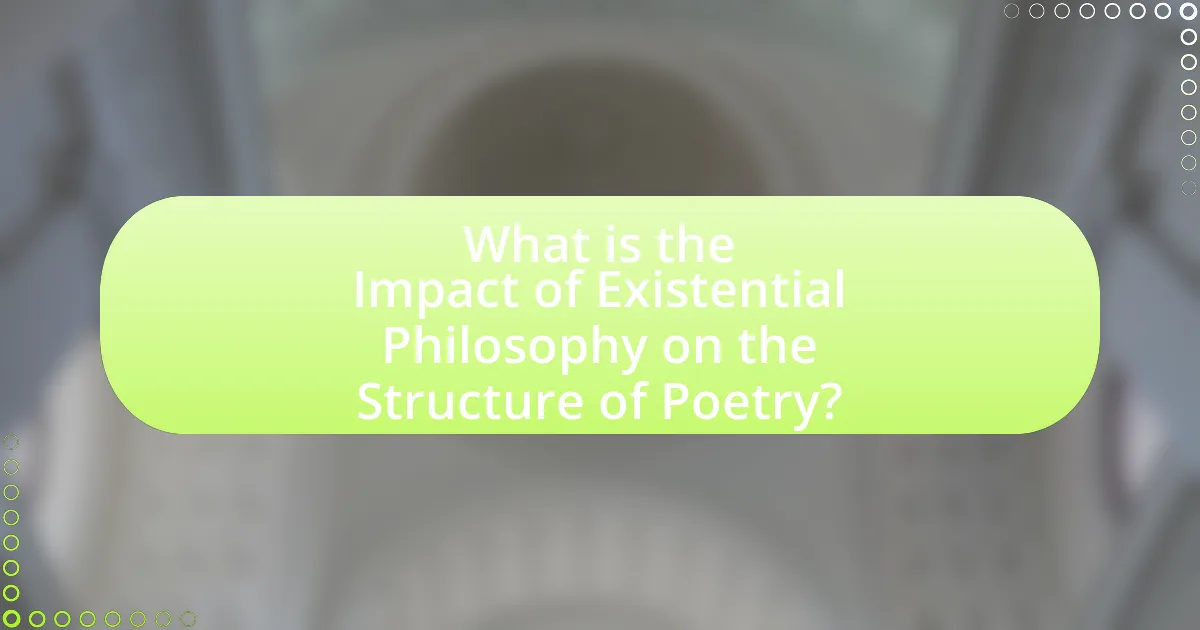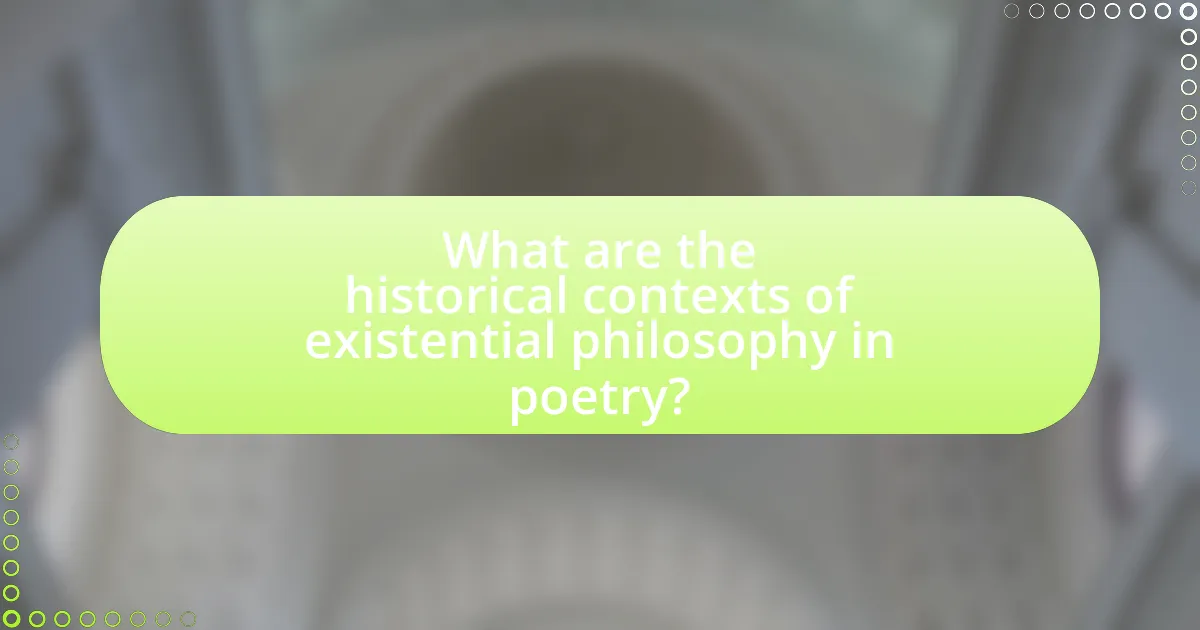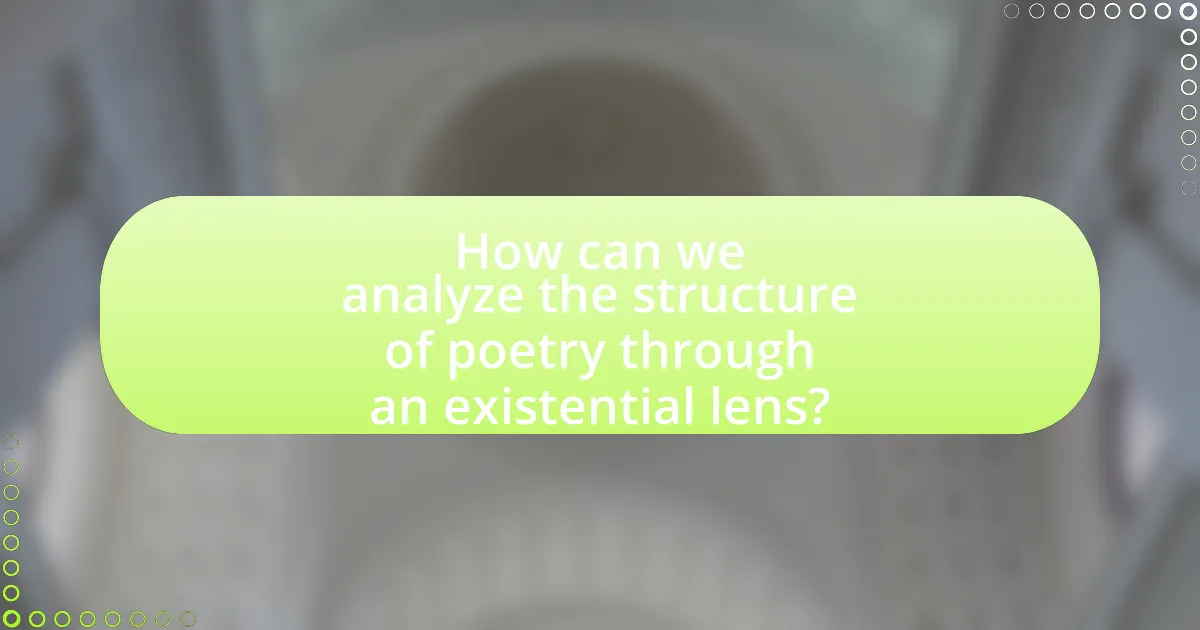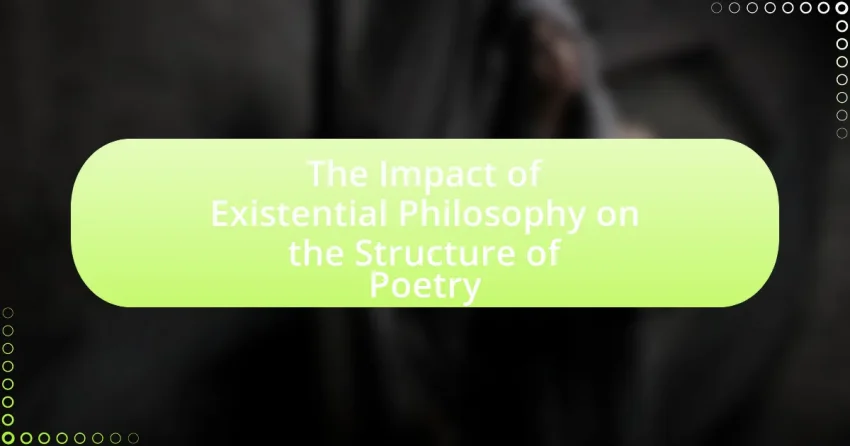The article examines the impact of existential philosophy on the structure of poetry, highlighting how themes of individual experience, freedom, and the search for meaning shape poetic forms and styles. It discusses the influence of poets such as T.S. Eliot and Sylvia Plath, who utilize fragmented structures and unconventional syntax to reflect existential dilemmas. Key existential themes explored include absurdity, isolation, and the inevitability of death, demonstrating how these concepts inform both the thematic depth and emotional resonance of poetry. The relationship between existential thought and poetic expression is analyzed, revealing its significance in modern and postmodern literary movements.

What is the Impact of Existential Philosophy on the Structure of Poetry?
Existential philosophy significantly influences the structure of poetry by emphasizing themes of individual experience, freedom, and the search for meaning. This philosophical approach encourages poets to explore fragmented forms, nonlinear narratives, and open-ended conclusions, reflecting the complexities of human existence. For instance, poets like Samuel Beckett and T.S. Eliot utilize disjointed structures and ambiguous language to convey existential dilemmas, illustrating the struggle for identity and purpose. The impact is evident in the use of free verse and unconventional syntax, which allows for a more authentic expression of the human condition, aligning with existentialist ideas that prioritize subjective experience over traditional forms.
How does existential philosophy influence poetic themes?
Existential philosophy profoundly influences poetic themes by emphasizing individual experience, freedom, and the search for meaning in an indifferent universe. Poets often explore existential concepts such as absurdity, alienation, and authenticity, reflecting the human condition’s complexities. For instance, the works of poets like T.S. Eliot and Sylvia Plath illustrate existential themes through their exploration of despair and the quest for identity in a fragmented world. This thematic focus aligns with existentialist thinkers like Jean-Paul Sartre and Albert Camus, who argue that individuals must create their own meaning amid existential angst. Thus, existential philosophy serves as a foundational framework that shapes the thematic depth and emotional resonance of poetry.
What are the key existential themes found in poetry?
Key existential themes found in poetry include the search for meaning, the absurdity of existence, isolation, freedom, and the inevitability of death. These themes reflect the human condition and the struggle to find purpose in a seemingly indifferent universe. For instance, poets like Samuel Beckett and T.S. Eliot explore the absurdity of life and the quest for meaning through fragmented narratives and existential imagery. Additionally, the theme of isolation is prevalent in the works of poets such as John Keats and Emily Dickinson, who often depict the individual’s emotional and existential solitude. The exploration of freedom, particularly in the context of choice and responsibility, is evident in the writings of poets like Rainer Maria Rilke. Lastly, the inevitability of death is a recurring motif, as seen in the works of poets like John Donne, who confront mortality and its implications on life. These themes collectively illustrate how existential philosophy shapes poetic expression and structure.
How do poets express existential angst through their work?
Poets express existential angst through their work by exploring themes of isolation, absurdity, and the search for meaning in a seemingly indifferent universe. This is evident in the use of fragmented structures, ambiguous language, and introspective imagery that reflect the inner turmoil of the human condition. For example, the works of poets like T.S. Eliot and Sylvia Plath often delve into the complexities of identity and the struggle against existential despair, showcasing how personal experiences can resonate with broader philosophical questions. Their poetry frequently employs stark contrasts and vivid metaphors to convey feelings of disconnection and existential dread, reinforcing the emotional weight of their themes.
In what ways does existential philosophy shape poetic form?
Existential philosophy shapes poetic form by emphasizing themes of individual experience, absurdity, and the search for meaning, which influence the structure and style of poetry. Poets influenced by existentialism often employ free verse, fragmented narratives, and unconventional syntax to reflect the complexity of human existence and the subjective nature of reality. For instance, the works of poets like Samuel Beckett and Paul Celan illustrate how existential themes manifest in their use of disjointed imagery and non-linear progression, mirroring the chaotic nature of life and the struggle for personal significance. This approach allows poets to convey profound emotional depth and existential angst, aligning the form of the poetry with its thematic content.
What structural elements are commonly altered by existential thought?
Existential thought commonly alters structural elements such as form, meter, and thematic focus in poetry. These alterations reflect the existential themes of absurdity, freedom, and individual experience. For instance, poets influenced by existentialism often abandon traditional forms and meters to convey a sense of disorientation and fragmentation, mirroring the existential belief in the chaotic nature of existence. This shift can be seen in the works of poets like Samuel Beckett and T.S. Eliot, who utilize free verse and unconventional structures to express the complexities of human existence and the search for meaning.
How do poets utilize free verse to convey existential ideas?
Poets utilize free verse to convey existential ideas by allowing for a fluid and unrestricted expression of thought and emotion, which mirrors the complexities of human existence. This form of poetry breaks away from traditional structures, enabling poets to explore themes such as absurdity, isolation, and the search for meaning without the constraints of rhyme or meter. For instance, Walt Whitman’s “Leaves of Grass” exemplifies this approach, as it embraces a conversational tone and varied line lengths to reflect the chaotic nature of life and the individual’s place within it. The lack of formal constraints in free verse allows poets to capture the nuances of existential thought, making their reflections on existence more relatable and impactful.
Why is the relationship between existential philosophy and poetry significant?
The relationship between existential philosophy and poetry is significant because it allows poets to explore themes of existence, meaning, and individual experience in a profound way. Existential philosophy emphasizes the individual’s search for meaning in an indifferent universe, which resonates deeply in poetry that grapples with human emotions, isolation, and the quest for authenticity. For instance, poets like T.S. Eliot and Sylvia Plath incorporate existential themes in their works, reflecting the complexities of human existence and the struggle for identity. This connection enriches poetry by providing a framework for expressing the nuances of the human condition, making it a vital aspect of literary exploration.
What insights can be gained from analyzing this relationship?
Analyzing the relationship between existential philosophy and the structure of poetry reveals how existential themes influence poetic form and expression. This relationship highlights the ways in which poets utilize structure to convey existential concepts such as absurdity, freedom, and the search for meaning. For instance, poets like Samuel Beckett and T.S. Eliot employ fragmented structures and unconventional syntax to reflect the disorientation and complexity of human existence, demonstrating that the form of poetry can mirror the philosophical inquiries of existentialism. This connection underscores the importance of structure in enhancing the thematic depth of poetry, as evidenced by the use of enjambment and irregular stanza lengths to evoke a sense of uncertainty and fluidity in existential thought.
How does this relationship reflect broader cultural movements?
The relationship between existential philosophy and the structure of poetry reflects broader cultural movements by illustrating the shift towards individualism and subjective experience in the 20th century. This philosophical framework emphasizes personal meaning and the absurdity of existence, which poets like T.S. Eliot and Sylvia Plath incorporated into their works, showcasing a departure from traditional forms and themes. For instance, Eliot’s “The Waste Land” employs fragmented structure and stream-of-consciousness techniques, mirroring the disillusionment and chaos of post-World War I society. This alignment with existential thought highlights a cultural movement that prioritizes personal introspection and the exploration of identity, resonating with the broader societal questioning of established norms and values during that era.

What are the historical contexts of existential philosophy in poetry?
Existential philosophy in poetry emerged prominently in the 20th century, particularly influenced by the aftermath of World War II and the rise of modernist literature. This philosophical movement, characterized by themes of absurdity, freedom, and individual existence, found expression in the works of poets such as T.S. Eliot and Samuel Beckett, who grappled with the disillusionment of contemporary life. The historical context includes the existential crises faced by individuals in a rapidly changing world, where traditional values were questioned, leading to a focus on personal experience and subjective reality in poetry. The existentialist emphasis on the individual’s search for meaning amidst chaos is evident in the fragmented structures and innovative forms adopted by poets during this period, reflecting the complexities of human existence.
How did existential philosophy emerge as a literary influence?
Existential philosophy emerged as a literary influence primarily through the works of key thinkers like Jean-Paul Sartre and Albert Camus, who explored themes of absurdity, freedom, and individual existence. Their philosophical ideas were translated into literature, particularly in novels and plays, where characters grappled with existential dilemmas, reflecting the human condition’s complexities. For instance, Sartre’s play “No Exit” illustrates the concept of “hell is other people,” emphasizing interpersonal relationships’ existential weight. This literary manifestation of existential thought significantly shaped modern poetry, encouraging poets to delve into personal experience and subjective reality, as seen in the works of writers like Sylvia Plath and T.S. Eliot, who incorporated existential themes into their poetic structures.
What historical events contributed to the rise of existentialism in literature?
The rise of existentialism in literature was significantly influenced by the aftermath of World War II, which exposed the absurdity of human existence and the fragility of life. The war led to widespread disillusionment with traditional values and beliefs, prompting writers to explore themes of alienation, freedom, and the search for meaning in a chaotic world. Additionally, the philosophical works of figures like Jean-Paul Sartre and Simone de Beauvoir, who articulated existentialist ideas during this period, provided a framework that resonated with the experiences of individuals grappling with the consequences of war and societal upheaval. These historical contexts solidified existentialism as a prominent literary movement, reflecting the complexities of human existence in a post-war society.
Which poets were pivotal in integrating existential philosophy into their work?
The poets pivotal in integrating existential philosophy into their work include T.S. Eliot, Wallace Stevens, and Paul Celan. T.S. Eliot’s “The Love Song of J. Alfred Prufrock” explores themes of alienation and the search for meaning, reflecting existential concerns. Wallace Stevens’ poetry often grapples with the nature of reality and the individual’s perception, as seen in “The Emperor of Ice-Cream.” Paul Celan’s work, particularly “Death Fugue,” addresses the absurdity of existence and the human condition in the face of trauma. These poets effectively weave existential themes into their poetry, demonstrating the profound impact of existential philosophy on their artistic expression.
What role did existential philosophy play in the evolution of poetic movements?
Existential philosophy significantly influenced the evolution of poetic movements by emphasizing individual experience, freedom, and the search for meaning in an absurd world. This philosophical framework inspired poets to explore themes of alienation, despair, and authenticity, leading to the emergence of movements such as Modernism and Surrealism. For instance, poets like T.S. Eliot and Wallace Stevens incorporated existential themes into their works, reflecting the fragmented nature of modern existence and the quest for personal truth. The existential focus on subjective experience reshaped poetic forms and styles, encouraging experimentation with structure and language to convey complex emotional landscapes.
How did existentialism influence modernist poetry?
Existentialism significantly influenced modernist poetry by emphasizing themes of individual experience, alienation, and the search for meaning in a seemingly indifferent universe. Poets such as T.S. Eliot and Wallace Stevens incorporated existentialist ideas, reflecting the fragmented nature of modern life and the inner turmoil of the self. For instance, Eliot’s “The Love Song of J. Alfred Prufrock” explores the protagonist’s existential crisis and feelings of isolation, mirroring existentialist concerns about the individual’s place in a chaotic world. This thematic focus on personal struggle and the absurdity of existence became a hallmark of modernist poetry, shaping its structure and style.
What impact did existential thought have on postmodern poetry?
Existential thought significantly influenced postmodern poetry by emphasizing themes of absurdity, alienation, and the search for meaning in a fragmented world. This philosophical perspective, rooted in the works of thinkers like Jean-Paul Sartre and Albert Camus, encouraged poets to explore the complexities of human existence and the subjective nature of reality. For instance, poets such as Charles Bukowski and Sylvia Plath incorporated existential themes, reflecting the inner turmoil and disconnection experienced in modern life. The use of fragmented structures and non-linear narratives in their works mirrors the existential belief in the chaotic nature of existence, thereby reshaping the conventions of poetry in the postmodern era.

How can we analyze the structure of poetry through an existential lens?
Analyzing the structure of poetry through an existential lens involves examining how themes of existence, meaning, and individual experience are reflected in poetic form. Existential philosophy emphasizes the individual’s search for meaning in an indifferent universe, which can be mirrored in the use of fragmented structures, free verse, and unconventional syntax in poetry. For instance, poets like T.S. Eliot and Sylvia Plath often employ disjointed narratives and varied line lengths to convey the complexities of human existence and emotional turmoil, illustrating the existential struggle. This approach allows readers to engage with the text on a deeper level, prompting reflection on their own existence and the nature of reality.
What techniques can be used to examine existential themes in poetry?
Techniques to examine existential themes in poetry include close reading, thematic analysis, and intertextuality. Close reading allows for a detailed examination of language, structure, and imagery, revealing how poets convey existential concerns such as meaning, isolation, and the human condition. Thematic analysis identifies recurring motifs and symbols that reflect existential dilemmas, such as absurdity and freedom. Intertextuality explores connections between a poem and philosophical texts or other literary works, providing context for understanding existential themes. These techniques are validated by literary criticism, which emphasizes the importance of textual analysis in uncovering deeper meanings in poetry.
How do literary devices enhance the expression of existential ideas?
Literary devices enhance the expression of existential ideas by providing tools that deepen emotional resonance and thematic complexity. For instance, symbolism allows poets to convey abstract concepts like absurdity and isolation through tangible images, making existential themes more relatable. Additionally, techniques such as stream of consciousness reflect the fragmented nature of human experience, mirroring existentialist notions of subjectivity and the search for meaning. The use of irony can also highlight the contradictions inherent in existence, emphasizing the tension between human aspirations and the indifferent universe. These devices collectively enrich the reader’s understanding of existential dilemmas, as seen in works by poets like T.S. Eliot and Sylvia Plath, who effectively utilize these techniques to explore the human condition.
What role does imagery play in conveying existential concepts?
Imagery plays a crucial role in conveying existential concepts by providing vivid representations that evoke emotional and intellectual responses. Through the use of sensory details, imagery allows poets to illustrate abstract ideas such as the search for meaning, the absurdity of existence, and the confrontation with mortality. For instance, in the works of existential poets like T.S. Eliot, imagery serves to depict fragmented realities and the inner turmoil of individuals grappling with their existence. This technique enhances the reader’s understanding of complex philosophical themes by grounding them in relatable experiences, thus making existential concepts more accessible and impactful.
What are some examples of poets who effectively blend existential philosophy with structure?
Some examples of poets who effectively blend existential philosophy with structure include T.S. Eliot, Wallace Stevens, and Sylvia Plath. T.S. Eliot’s “The Love Song of J. Alfred Prufrock” employs a fragmented structure that mirrors the protagonist’s existential crisis, reflecting themes of alienation and self-doubt. Wallace Stevens’ “The Emperor of Ice-Cream” uses a structured form to explore the nature of reality and the human experience, emphasizing the tension between existence and perception. Sylvia Plath’s “Lady Lazarus” combines a rigid stanzaic form with existential themes of identity and rebirth, illustrating the struggle against despair. These poets demonstrate how structured forms can enhance the exploration of existential ideas in their work.
How does the work of specific poets illustrate the impact of existential thought on poetic structure?
The work of poets such as T.S. Eliot and Sylvia Plath illustrates the impact of existential thought on poetic structure through their use of fragmented forms and introspective themes. T.S. Eliot’s “The Love Song of J. Alfred Prufrock” employs stream-of-consciousness and disjointed imagery to reflect the protagonist’s existential crisis, showcasing how the structure mirrors the chaotic nature of modern existence. Similarly, Sylvia Plath’s “Lady Lazarus” utilizes a confessional style and abrupt shifts in tone to convey themes of identity and rebirth, emphasizing the struggle against despair inherent in existential philosophy. These structural choices highlight the poets’ engagement with existential themes, reinforcing the notion that form and content are deeply intertwined in expressing the complexities of human experience.
What can we learn from these examples about the relationship between philosophy and poetry?
The relationship between philosophy and poetry reveals that existential philosophy profoundly influences poetic structure and themes. Existentialism, with its focus on individual experience, freedom, and the search for meaning, often manifests in poetry through fragmented forms, stream-of-consciousness techniques, and explorations of identity. For instance, poets like T.S. Eliot and Sylvia Plath incorporate existential themes, reflecting the complexities of human existence and emotional turmoil, which aligns with existentialist thought. This connection illustrates how philosophical ideas can shape poetic expression, leading to innovative structures that convey deep existential inquiries.
What practical approaches can poets take to incorporate existential philosophy into their work?
Poets can incorporate existential philosophy into their work by exploring themes of absurdity, freedom, and individual existence. They can utilize techniques such as stream-of-consciousness writing to reflect the chaotic nature of human experience, as seen in the works of poets like T.S. Eliot and Sylvia Plath. Additionally, poets can employ imagery that evokes existential questions, such as isolation and the search for meaning, which is evident in the poetry of Rainer Maria Rilke. By engaging with philosophical texts, such as those by Jean-Paul Sartre or Albert Camus, poets can deepen their understanding of existential concepts and integrate these ideas into their verse, thereby enriching their exploration of the human condition.
